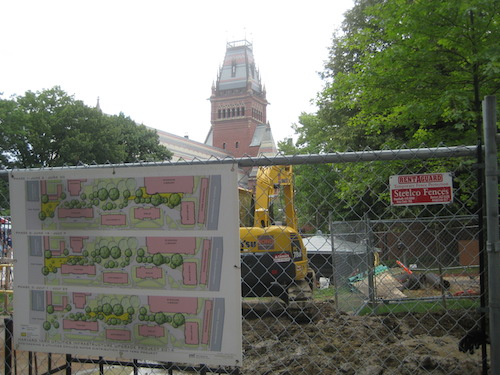
I work at Harvard. And right now, I work in a construction zone.
For the past year and a half, I’ve worked in a red brick building on Appian Way, a quiet Cambridge street several blocks northwest of the bustling center of Harvard Square. And for months now, since the construction crew began work on a project that includes adding two new floors to our building and various other improvements, we’ve lived with the sounds of drills, jackhammers, and construction workers shouting instructions to one another. The elevator is permanently out of service until it can be brought up to code. Scaffolding wraps around the outside walls of our building, and a thick film of construction dust coats the windows in our ground-level office suite. By the time you read this, my colleagues and I will have moved across the street to a temporary office suite in the library so the construction crew can install a (long overdue) sprinkler system in our usual location.
Over in Harvard Yard, three blocks away, it’s a similar story.
During the university’s summer break, when the red brick dormitories lining the Yard are only half full and the foot traffic consists mostly of tourists, crews of hard-hatted workers are digging up mounds of dirt and concrete, working to improve the Yard’s underground pipe system. The John Harvard statue in front of University Hall, a popular spot for tourists to pose, remains unobstructed, but tour groups and camera-toting visitors have to step carefully around chain-link fences and caution tape nearby.
On the one hand, this construction site chaos makes total sense. Harvard is an ancient university, founded before the nation it sits within, so naturally it requires maintenance, even overhauling, from time to time. Time-worn plumbing, bricks and even concrete don’t last forever; eventually, everything must be reinforced, shored up, even replaced.
On the other hand, Harvard and its Ivy League peers pride themselves on doing everything the right way, the smart way. Why, then, would they have to periodically rip everything up (or at least large portions of everything) and start again?
The simplest answer in this case turns out to be the right one: because things change.
Buildings warp and lean with time, sustaining damage from severe weather or the constant wear of day-in, day-out traffic. Safety codes change, requiring new (often expensive) additions to keep buildings compliant. Student and faculty populations swell and threaten to outgrow their spaces. In beautiful, historic, crowded Cambridge, it is nearly impossible to simply buy new, empty land and put up a building. Instead of building out, you have to build up — as seen in the building I work in — or you have to think creatively, renovating your existing space to meet new needs. Instead of employing a slash-and-burn policy, you have to work with what’s already there, often creating something entirely new in the process.
I’ve worked in higher education for nearly a decade, since graduating from college (in a sense, I’ve never really left). In my time at two small liberal arts colleges and now at Harvard, I’ve heard a lot of talk about the shortcomings of higher education and education in general: its high costs (both financial and personal), its adherence to hidebound ideas, its slowness to change, its constant failure to provide a top-quality education for every kind of student. Many of those accusations have merit: even at Harvard, things are never perfect. But neither are they stagnant. As it is in our buildings and physical campus, so it is in our classrooms, our campus spaces and especially our ideas: we are always being made new.
Periodically, whether it’s occasioned by new technology, world events, or simply a major shift in the prevailing scientific, philosophical, or social realm, ideas are forced to change. Most universities in this country, including Harvard, began as men-only institutions full of (mostly) wealthy white students. Seminal discoveries in the sciences have repeatedly transformed the way physics, chemistry, and other science classes are taught. The shifts in literature and criticism (my home turf) may be subtler to an outside observer, but every so often, new philosophies seem to rise from the ashes of what came before. But the foundations of previous ideas don’t disappear: they are still there, underpinning and influencing the new ideas.
When the dust settles on Appian Way in a few months, our building will stand taller and prouder than it did before. Our repaired elevator will be safer and roomier, our offices better protected in case of fire. But the two new floors would not have been possible without the existing three stories (and basement) underneath. The addition is only made possible by what came before.
So it is in the realm of ideas, and in my own life on a smaller scale. Each journal entry, blog post, essay, or nascent book idea builds on the years of reading, writing, and living that came before it. I am always seeking to hone my technique, to generate new and creative ideas, to find a different way of looking at the world. But like the construction workers, I have to build on what’s already there. I have to strike a balance, uneasy though it may be, of honoring the strength of the old, and creating a little chaos to bring in the new.
Katie Noah Gibson is a writer, editor, knitter, and compulsive tea-drinker living in the Boston area. Born in Texas, she’s a lifelong Anglophile but loves to travel just about anywhere. You can find her at her blog, Cakes, Tea and Dreams, reviewing books at Shelf Awareness, or on Twitter at @katiengibson.














